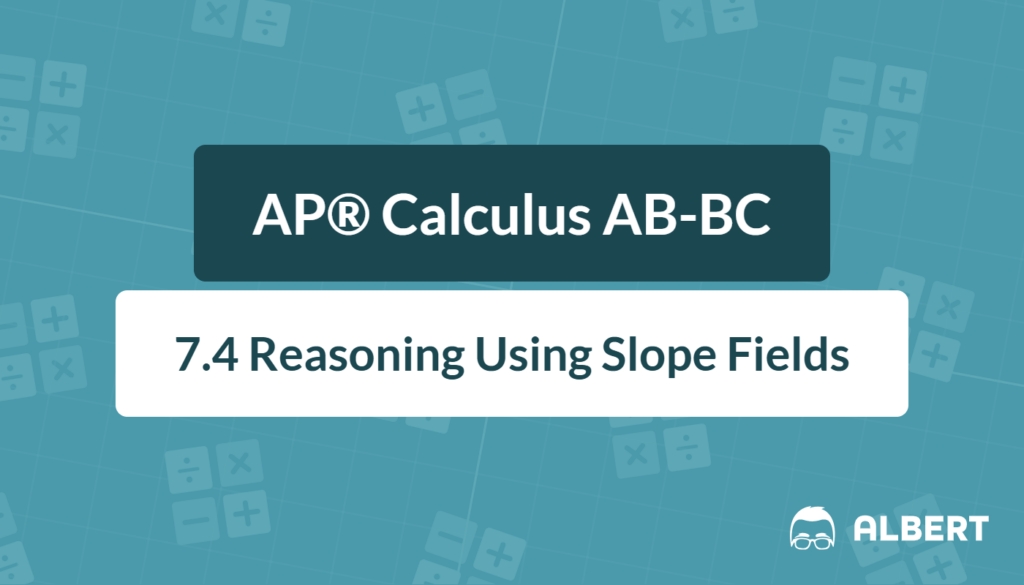Slope fields look mysterious at first, yet they show up in multiple-choice and free-response questions on the AP® exam. A slope field is simply a picture of the tiny slopes produced by a differential equation. Therefore, it lets students “see” solutions without solving analytically. This article on 7.4 reasoning using slope fields explains how the picture is built, how to read it, and how to select a particular solution that meets an initial condition. The ideas line up with learning objective FUN-7.C.3: recognizing that solutions form a family of curves. By the end, students will be able to sketch, interpret, and match slope fields with confidence.
What We Review
Why Slope Fields Matter
Differential equations in plain language
A differential equation (DE) connects a function y with its derivative \dfrac{dy}{dx}. In other words, it states how fast the function changes at each point.
Families of functions
Because a DE gives only the rate of change, there is usually more than one function that fits. Hence, the complete answer is a family of curves.
Analogy
Think of a slope field like a topographical map. Each mini-segment is an arrow of steepness, just as a contour line suggests terrain. Following those arrows traces a path, similar to walking downhill or uphill on a hill.
Building a Slope Field from a Differential Equation
What \dfrac{dy}{dx} provides
At any point (x,y), the DE returns a numeric slope. Consequently, one can draw a short line segment with that tilt.
Step-by-step How-To
- Pick a lattice of points, such as every integer pair in a window.
- Next, plug each point into the DE to get the slope.
- Then draw a mini-segment (all segments the same short length for clarity).
Example 1: Constructing the slope field for \dfrac{dy}{dx}=x-y
Four points will illustrate the process.
| Point | Slope calculation | Mini-segment slope |
| (0,0) | 0-0=0 | horizontal |
| (1,0) | 1-0=1 | 45° upward |
| (0,1) | 0-1=-1 | 45° downward |
| (1,1) | 1-1=0 | horizontal |
Therefore, when the grid is filled, students see horizontal segments along the line y=x and steeper lines farther away.
Reading and Reasoning with Slope Fields
Spotting trends
- If segments tilt upward, the solution is increasing.
- If they tilt downward, the solution is decreasing.
- Curvature hints at concavity; if slopes increase as you move right, the graph is concave up.
Matching a slope field to a differential equation
Exam questions often present three candidate DEs. The key is to test signs. For instance, if the field shows positive slopes above the x-axis and negative below, then \dfrac{dy}{dx} likely involves y.
Example 2: Which DE matches the field?
Suppose a field shows these patterns:
- Slopes are zero along y=0.
- Slopes are positive when y>0.
- Slopes are negative when y<0.
Candidates:
- \dfrac{dy}{dx}=y
- \dfrac{dy}{dx}=-y
- \dfrac{dy}{dx}=x+y
Because slopes change sign exactly with y, choice 1 fits. Therefore, the correct DE is \dfrac{dy}{dx}=y.
Graphing a solution curve
To draw a solution through (0,2), start at that point and, meanwhile, follow the arrows smoothly forward and backward. The resulting curve hugs the “stream” suggested by the segments.
Particular vs. General Solutions
Selecting one curve
A general solution is the entire family, often written with “+C.” However, an initial condition like y(0)=2 chooses one specific path—called a particular solution.
Example 3: Logistic growth
DE: \dfrac{dy}{dx}=y\left(1-\dfrac{y}{5}\right)
Initial condition: y(0)=2
Step-by-step sketch:
- At (0,2), compute slope:
- 2\left(1-\frac{2}{5}\right)=2\left(\frac{3}{5}\right)=\frac{6}{5}; draw a segment tilting upward.
- Next, move slightly right; slopes rise until y=2.5, then gradually shrink as y approaches 5.
- Therefore, the curve levels out near the carrying capacity y=5.
Connection to FUN-7.C.3
The logistic family has infinitely many S-shaped curves, one for each starting value. An initial condition simply locks in the right S-curve.
Common AP® Exam Tasks Involving Slope Fields
- Rapid identification: Multiple-choice items may ask which graph matches a given DE. Quickly check where slopes are zero or positive.
- Free-response: Students might describe behavior (“the solution is decreasing for x<0”) or estimate a value by following the field.
- Quick tips
- Count sign changes along axes.
- Look for symmetry; odd functions produce rotationally symmetric fields.
Quick Reference Vocabulary Chart
| Term | Definition |
| Differential Equation | An equation containing \dfrac{dy}{dx} |
| Slope Field | Grid of tiny line segments showing slope at each point |
| Initial Condition | A given point like y(1)=3 |
| Family of Curves | All functions satisfying the DE |
| Particular Solution | The single curve that meets an initial condition |
Conclusion
Slope fields offer a visual gateway into differential equations. They reveal where a function climbs, falls, or levels off without solving a single integral. Mastery of 7.4 reasoning using slope fields therefore strengthens both conceptual understanding and exam performance. Keep practicing these pictures, and the once-mysterious arrows will soon guide problem-solving with clarity.
Sharpen Your Skills for AP® Calculus AB-BC
Are you preparing for the AP® Calculus exam? We’ve got you covered! Try our review articles designed to help you confidently tackle real-world math problems. You’ll find everything you need to succeed, from quick tips to detailed strategies. Start exploring now!
Need help preparing for your AP® Calculus AB-BC exam?
Albert has hundreds of AP® Calculus AB-BC practice questions, free responses, and an AP® Calculus AB-BC practice test to try out.








